Related Research Articles

Earl Grey is a title in the peerage of the United Kingdom. It was created in 1806 for General Charles Grey, 1st Baron Grey. In 1801, he was given the title Baron Grey of Howick in the County of Northumberland, and in 1806 he was created Viscount Howick in the County of Northumberland, at the same time as he was given the earldom. A member of the prominent Grey family of Northumberland, Earl Grey was the third son of Sir Henry Grey, 1st Baronet of Howick.
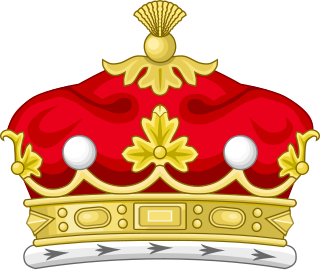
Marquess of Linlithgow, in the County of Linlithgow or West Lothian, is a title in the Peerage of the United Kingdom. It was created on 23 October 1902 for John Hope, 7th Earl of Hopetoun. The current holder of the title is Adrian Hope.

Earl of Galloway is a title in the Peerage of Scotland. It was created in 1623 for Alexander Stewart, 1st Lord Garlies, with remainder to his heirs male bearing the name and arms of Stewart. He had already been created Lord Garlies in the Peerage of Scotland in 1607, with remainder to the heirs male of his body succeeding to the estates of Garlies. This branch of the Stewart family were distant relatives of the Stewart Kings of Scotland.

Earl of Cromartie is a title that has been created twice, both for members of the Mackenzie family. It was first created as Earl of Cromarty in the Peerage of Scotland in 1703 for Sir George Mackenzie, 2nd Baronet, but his titles were forfeited after the Jacobite rising of 1745. It was recreated in 1861 in the Peerage of the United Kingdom for Anne Sutherland-Leveson-Gower, Duchess of Sutherland. Since 1979, the Earl of Cromartie has been chief of Clan Mackenzie.

Earl Cowper was a title in the Peerage of Great Britain. It was created in 1718 by George I for William Cowper, 1st Baron Cowper, his first Lord Chancellor, with remainder in default of male issue of his own to his younger brother, Spencer Cowper. Cowper had already been created Baron Cowper of Wingham in the County of Kent, in the Peerage of England on 14 December 1706, with normal remainder to the heirs male of his body, and was made Viscount Fordwich, in the County of Kent, at the same time as he was given the earldom, also Peerage of Great Britain and with similar remainder. He was the great-grandson of William Cowper, who was created a Baronet, of Ratling Court in the County of Kent, in the Baronetage of England on 4 March 1642. The latter was succeeded by his grandson, the second Baronet. He represented Hertford in Parliament. He was succeeded by his eldest son, the aforementioned William Cowper, the third Baronet, who was elevated to the peerage as Baron Cowper in 1706 and made Earl Cowper in 1718. In 1706 Lord Cowper married as his second wife Mary Clavering, daughter of John Clavering, of Chopwell, County Durham.

Brigadier-General Sir John Johnson, 2nd Baronet was an American-born military officer, magistrate, landowner in the British Indian Department who fought as a Loyalist during the American Revolutionary War. He was the son of Sir William Johnson, 1st Baronet, who was the first British Superintendent of Indian Affairs. He inherited his father's baronetcy and estate in 1774.

The Royal Scots Fusiliers was a line infantry regiment of the British Army that existed from 1678 until 1959 when it was amalgamated with the Highland Light Infantry to form the Royal Highland Fusiliers which was later itself merged with the Royal Scots, King's Own Scottish Borderers, the Black Watch, the Argyll and Sutherland Highlanders and the Highlanders to form a new large regiment, the Royal Regiment of Scotland.
There have been two baronetcies created for members of the Orr-Ewing family, both in the Baronetage of the United Kingdom. Both creations are extant as of 2010.
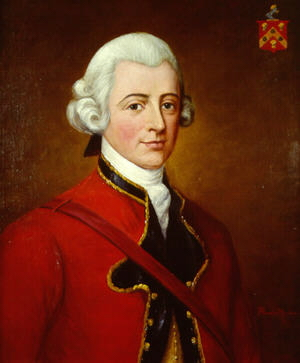
The Eden Baronetcy, of West Auckland in the County of Durham, and the Eden Baronetcy, of Maryland in North America, are two titles in the Baronetage of England and Baronetage of Great Britain respectively that have been united under a single holder since 1844.
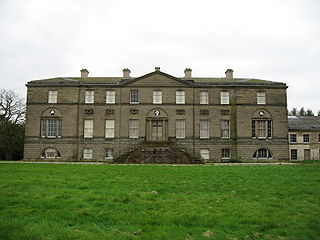
The Broughton, later Broughton-Delves, later Broughton Baronetcy, of Broughton in the County of Stafford, is a title in the Baronetage of England. It was created on 10 March 1661 for Sir Brian Broughton, of Broughton Hall, near Eccleshall, Staffordshire, High Sheriff of Staffordshire from 1660 to 1661 and the member of an ancient Staffordshire family.

The HaringtonBaronetcy, of Ridlington in the county of Rutland, is a title in the Baronetage of England. It was created on 29 June 1611 for James Harington. He was a descendant of John Harington, one of the Barons summoned to Parliament by Edward II. James's elder brother was John Harington, 1st Baron Harington of Exton. The second Baronet was a Royalist during the English Civil War. The third Baronet was a Major-General in the Parliamentarian Army and one of the judges appointed to try Charles I, although he refused to sit. He was nonetheless excepted from the Indemnity and Oblivion Act and his title was forfeited for life in 1661. The ninth and twelfth Baronets were both judges.

There have been four baronetcies created for members of the Acland family, which originated in the 12th century at the estate of Acland in the parish of Landkey, North Devon, two in the Baronetage of England and two in the Baronetage of the United Kingdom.
Sir James Campbell, 2nd Baronet of Ardkinglass, was a British Army officer and Scottish politician who sat in the Parliament of Scotland from 1703 to 1707 and in the British House of Commons from 1707 to 1741.
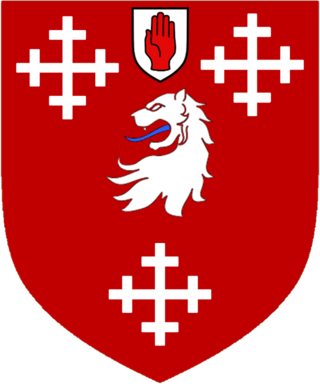
There have been two baronetcies created for members of the Armytage family, one in the Baronetage of England and one in the Baronetage of Great Britain. One creation is extant as of 2008.

There have been three baronetcies created for persons with the surname Chichester, one in the Baronetage of England and two in the Baronetage of the United Kingdom. Only the 1641 creation is extant.

There have been four baronetcies created for persons with the surname Gilmour, two in the Baronetage of Nova Scotia and two in the Baronetage of the United Kingdom. The former two are extinct and the latter two are extant.
There have been two baronetcies created for persons with the surname Curtis, one in the Baronetage of Great Britain and one in the Baronetage of the United Kingdom. One creation is extant as of 2007.
There have been five baronetcies created for members of Clan Ramsay, four in the Baronetage of Nova Scotia and one in the Baronetage of the United Kingdom. The baronetcy in the Baronetage of the United Kingdom is extant as of 2023.
Sir John Buckworth, 2nd Baronet (1704–1759), of Rathbone Place, London, and West Sheen, Surrey, was a British politician who sat in the House of Commons from 1734 to 1741.
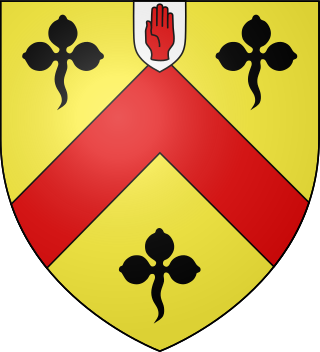
The Abdy baronetcy, of Felix Hall, in the County of Essex, was created in the Baronetage of England on 14 July 1641 for Thomas Abdy who was High Sheriff of Essex. The title became extinct in 1868.
References
- James Clark, Historical Record and Regimental Memoir of the Royal Scots Fusiliers (Edinburgh, 1885) page 97
- George Edward Cokayne, The Complete Baronetage, volume IV (Exeter, 1904) page 254